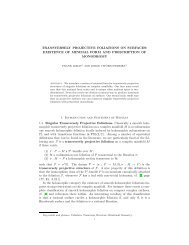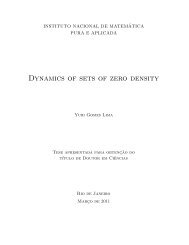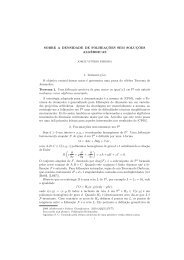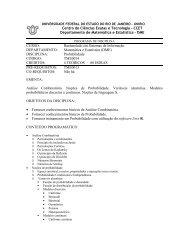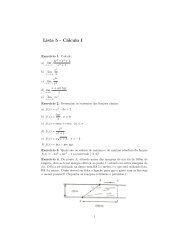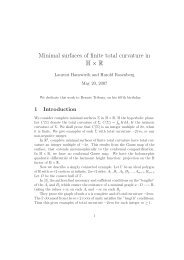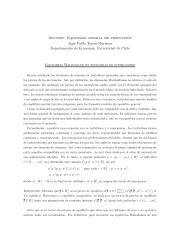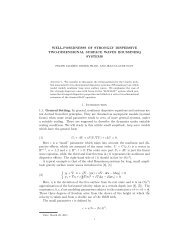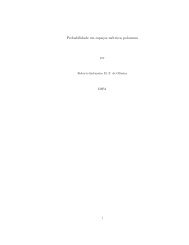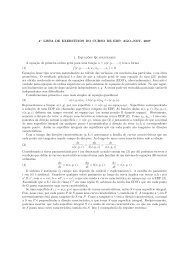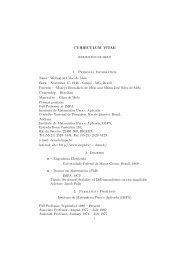Warping and Morphing of Graphical Objects - Impa
Warping and Morphing of Graphical Objects - Impa
Warping and Morphing of Graphical Objects - Impa
Create successful ePaper yourself
Turn your PDF publications into a flip-book with our unique Google optimized e-Paper software.
<strong>Warping</strong> <strong>and</strong> <strong>Morphing</strong> <strong>of</strong><br />
<strong>Graphical</strong> <strong>Objects</strong><br />
Jonas Gomes<br />
IMPA, Rio de Janeiro
Abstraction Pipeline<br />
• define a graphical object<br />
• define warping <strong>and</strong> morphing
<strong>Graphical</strong> <strong>Objects</strong><br />
Drawings Volume data Images
Sound<br />
<strong>Graphical</strong> <strong>Objects</strong><br />
Surface
• Shape<br />
<strong>Graphical</strong> Object<br />
• Geometry<br />
• Topology<br />
• Attributes<br />
• Properties<br />
• Color, temperature, texture, ...
<strong>Graphical</strong> Object<br />
• Same shape (rectangle)<br />
• Different attributes (texture)
<strong>Graphical</strong> Object<br />
• Physical attributes
• Shape<br />
• Attributes<br />
Definition <strong>of</strong> a<br />
<strong>Graphical</strong> Object<br />
• Dimension <strong>of</strong> the GO
Image<br />
• Shape is a rectangle<br />
• Attribute is color<br />
• Dimension = 2
Audio<br />
• Shape is an interval<br />
• Attribute is pressure<br />
• Dimension = 1
Solid (volumetric object)<br />
• Shape is an spacial<br />
domain<br />
• Attributes: density, ...<br />
• Dimension = n
Curves (Drawings)<br />
• One-dimensional graphical<br />
objects <strong>of</strong> the plane
Surfaces<br />
• Two-dimensional graphical<br />
objects <strong>of</strong> the space
Two-Dimensional Solids<br />
• 2D graphical objects <strong>of</strong> the plane<br />
• Binary image<br />
• Shape is the focus
Animation<br />
• Variation <strong>of</strong> a graphical object<br />
along the time<br />
time
Transformation <strong>of</strong> <strong>Graphical</strong><br />
<strong>Objects</strong><br />
• Transforming shape<br />
• Transforming attributes
Transforming Shape<br />
• transformation <strong>of</strong> the image shape
Transforming Attributes<br />
• Texture transformation
Transforming<br />
Shape <strong>and</strong> Attributes<br />
Color <strong>and</strong><br />
Geometry<br />
Color,<br />
Geometry<br />
<strong>and</strong><br />
Topology
Classes <strong>of</strong> Transformation<br />
• Distance between points<br />
• Isometry<br />
• Contraction<br />
• Expansion
Classes <strong>of</strong> Transformation<br />
isometry expansion contraction<br />
• Change <strong>of</strong> frequencies
Mixed transformation
Our goal:<br />
Continuous Deformation
Continuous Deformation<br />
• Twist: Rotation angle increases<br />
with height
Continuous twist<br />
• Parameter space (z axis)
Families <strong>of</strong> Transformations<br />
<strong>Graphical</strong> Object<br />
Parameter Space<br />
p<br />
v<br />
T(p,v) =
t<br />
f<br />
From families to animation<br />
f(t)
• <strong>Warping</strong><br />
<strong>Warping</strong> <strong>and</strong> <strong>Morphing</strong><br />
• continuous family <strong>of</strong> transformations<br />
<strong>of</strong> a graphical object<br />
• <strong>Morphing</strong> (metamorphosis)<br />
• warping between two graphical<br />
objects
<strong>Warping</strong> <strong>and</strong> <strong>Morphing</strong><br />
• <strong>Warping</strong><br />
• Source object<br />
• No target object<br />
• <strong>Morphing</strong><br />
• Source object<br />
• Target object
<strong>Warping</strong><br />
• Continuous shape transformation<br />
• Warp the object shape<br />
• Change geometry <strong>and</strong> topology<br />
• Continuous attribute transformation<br />
• Change the attributes
<strong>Morphing</strong><br />
• Continuous shape blending<br />
• Continuous attribute blending
Source<br />
Shape Warp
Shape Blending<br />
Source Target
Linear Blending<br />
• A <strong>and</strong> B objects in a vector space<br />
c(t) = (1 - t) A + t B<br />
c(0) = A, c(1) = B<br />
• Functions (attributes)<br />
• Subsets <strong>of</strong> space (shape)
Bilinear Blending<br />
• Trilinear blending
Affine blending<br />
• Linear in barycentric coordinates
Attribute Blending<br />
• Linear Color Interpolation<br />
(cross dissolve)
Shape Warp + Attribute<br />
Blending<br />
• Adaptive Color Interpolation
Some Guidelines for a good<br />
morphing<br />
• Feature preservation<br />
• Smoothness preservation<br />
• Avoid linearities<br />
• use adaptive methods
Aligning features<br />
+ +<br />
= =
Comparison<br />
• Feature alignment<br />
• Adaptive color blending
Description <strong>of</strong> <strong>Graphical</strong> <strong>Objects</strong><br />
• Function description<br />
• shape<br />
• attributes<br />
• Description methods<br />
• implicit<br />
• parametric<br />
• algorithmic (virtual machine)
Unifying the problem<br />
• Function description<br />
• graphical objects<br />
■ shape<br />
■ attributes<br />
• Transformations<br />
■ warping<br />
■ morphing
Function description<br />
• Spatial (time) domain<br />
Variation <strong>of</strong> physical magnitudes
Spatial (time) domain<br />
• Audio: (time, amplitude)
Function description<br />
• Frequency domain<br />
amplitude<br />
frequency<br />
Occurrence <strong>of</strong> frequencies on the function
Frequency domain<br />
Description
Function description<br />
• time-frequency domain<br />
frequency<br />
• Frequencies on a period <strong>of</strong> time<br />
• Uncertainty principle<br />
time
Time-frequency domain<br />
Description
Function description<br />
• Time-scale domain<br />
For each scale, describes frequencies<br />
on a certain period <strong>of</strong> time
Time-scale description<br />
scale increases
Conversion between<br />
descriptions<br />
• Function Transforms<br />
• Fourier transform<br />
• Window Fourier transform<br />
• Wavelets<br />
• etc.<br />
• Invertibility
Some Guidelines for a<br />
good morphing<br />
• Avoid linearities (adaptiveness)<br />
• Bilinear map <strong>of</strong> chessboard
Some Guidelines for a<br />
good morphing<br />
• Avoid linearities<br />
• Projective mapping <strong>of</strong> chessboard
Yet another example:
Better advice<br />
• Keep linear morphing as an option<br />
• Effectiveness <strong>of</strong> linear morphing<br />
• Depends on the objects<br />
• Depends on the description <strong>of</strong> the objects<br />
■ Audio<br />
■ Animation
Linear warp <strong>of</strong> audio<br />
• time domain
Linear warp <strong>of</strong> audio<br />
• frequency domain
Linear warp <strong>of</strong> motion<br />
• Animation: one-parameter family
Motion paths<br />
• Spatial variation <strong>of</strong> samples<br />
• Motion warping
Motion <strong>Warping</strong><br />
• Andrew Witkin <strong>and</strong> Zoran Popovic<br />
Motion <strong>Warping</strong>.<br />
SIGGRAPH ‘95 Proceedings
Motion <strong>of</strong> articulated body<br />
• Hierarchy <strong>of</strong> joints<br />
• j 1, j 2, ..., j n<br />
• Joint motion<br />
• translation<br />
• rotation angles
• Joint j m<br />
• Joint angles<br />
Joint motion<br />
x<br />
z<br />
j m<br />
y
Human body motion<br />
• periodic motion <strong>of</strong> joints<br />
• Fourier description
Linear motion blending
Linear motion blending<br />
• interpolation<br />
• 0 < s < 1<br />
• extrapolation<br />
• s < 0<br />
• s > 1
References<br />
• Unuma, M.; Anjyo, K. ; Takeuchi, R.:<br />
Fourier Principles for Emotionbased<br />
Human Figure Animation.<br />
SIGGRAPH ‘95 Proceedings.
Where to go?<br />
• <strong>Graphical</strong> objects<br />
• Transformations
Representation <strong>of</strong> <strong>Graphical</strong> <strong>Objects</strong><br />
<strong>and</strong> Transformations<br />
• Representation <strong>of</strong> functions<br />
Function<br />
Description<br />
Function<br />
Representation<br />
Continuous Discrete
Represent shape
• Quantization<br />
• Computation<br />
• Perception<br />
Represent attributes
Represent transformations<br />
• <strong>Warping</strong> <strong>and</strong><br />
<strong>Morphing</strong><br />
• Motion paths<br />
• Time discretization
Unifying the problem<br />
• <strong>Graphical</strong> objects<br />
• Transformations<br />
• Study <strong>of</strong> functions<br />
• function description<br />
• function representation
Representation <strong>and</strong> Reconstruction<br />
Continuous<br />
Representation Reconstruction<br />
Discrete
What does Reconstruction buy?<br />
• User interaction<br />
• visualization<br />
• audio playing<br />
• Operations<br />
• warping<br />
• morphing<br />
• Specification
User<br />
Specification<br />
Representation <strong>and</strong><br />
Specification<br />
Function<br />
Representation<br />
• Specification <strong>of</strong> graphical objects<br />
• Specification <strong>of</strong> transformations<br />
Continuous<br />
function
Function Representation<br />
• function decomposition<br />
• Dictionary
Representation <strong>and</strong> Reconstruction<br />
• Reconstruction Interpolation
Point Sampling
Point Sampling<br />
• dictionary functions: Dirac delta<br />
• Dirac delta decomposition
Representation <strong>and</strong> Reconstruction<br />
• Exact representation<br />
• recover the geometry<br />
• recover the attributes<br />
• Non-exact representation<br />
• different flavors<br />
■ approx. geometry + same topology<br />
■ approx. geometry + different topology
Shape Reconstruction<br />
• geometry <strong>and</strong> topology
Shape Reconstruction<br />
• linear <strong>and</strong> cubic reconstruction
• Point sampling<br />
Polygonal B-Rep<br />
• Piecewise linear reconstruction<br />
• Curves <strong>and</strong> surfaces
Matrix Representation<br />
• Uniform decomposition (grid)<br />
• images<br />
• volume data
Rasterization<br />
• Computation <strong>of</strong> the matrix<br />
representation<br />
• grid definition<br />
• attributes computation<br />
• quantization<br />
• Spatial resolution<br />
• Attribute resolution
Matrix Representations
Problems <strong>of</strong> Function Representation<br />
• Define the function space<br />
• Define the dictionary<br />
• Construct the dictionary<br />
• Compute the coefficients
Problems <strong>of</strong> Function Reconstruction<br />
• Define reconstruction basis<br />
• Infinity elements on the basis<br />
• Basis function extends to infinity<br />
• Representation not exact
Point Sampling
Point sampling: Aliasing
Aliasing Artifacts
Aliasing <strong>and</strong> Reconstruction
Average Sampling<br />
• dictionary functions<br />
• average decomposition
Average sampling<br />
• Low-pass filtering<br />
• eliminate high frequencies<br />
• Point sampling
Average Methods<br />
• Box average
Average Methods<br />
• Triangle average
Higher Order Averages<br />
• quadratic<br />
• cubic<br />
• Gaussian, ...
Other Representations<br />
• Different descriptions<br />
• Time-frequency<br />
• Scale-frequency<br />
• Wavelets
Transforming <strong>Graphical</strong> <strong>Objects</strong><br />
• Resampling
Object Resampling
Some Guidelines for a<br />
good <strong>Morphing</strong><br />
• Topology preservation
Some Guidelines for a<br />
good <strong>Morphing</strong><br />
• Monotonicity
Some Guidelines for a good <strong>Morphing</strong><br />
• Use <strong>of</strong> transformation groups<br />
Bilinear warping<br />
Projective warping
Some Guidelines for a good <strong>Morphing</strong><br />
t<br />
• Slow-in <strong>and</strong> slow-out<br />
f<br />
f(t)
Some Guidelines for a good <strong>Morphing</strong><br />
• Avoid leakage<br />
<strong>Warping</strong> with leakage <strong>Warping</strong> the foreground<br />
to avoid leakage



